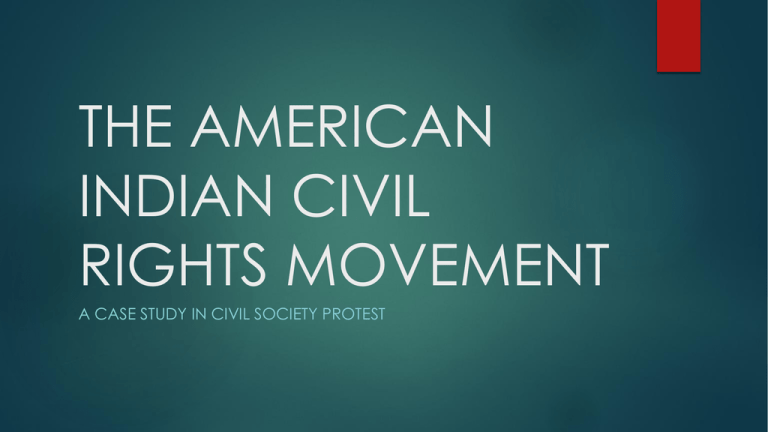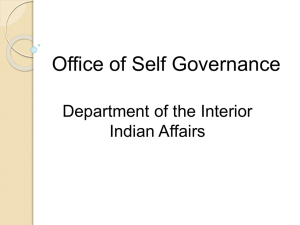3) The American Indian Civil Rights Movement
advertisement

THE AMERICAN INDIAN CIVIL RIGHTS MOVEMENT A CASE STUDY IN CIVIL SOCIETY PROTEST CHANGING AMERICAN INDIAN POLICY • • • • • • • Open warfare, followed by treaty-making, beginning in 1778 Forced removal of Eastern Indians to west of the Mississippi River, the Indian Removal Act of 1830 (the “Trail of Tears”, beginning in 1831) Confinement to reservations Economic and cultural assimilation including acculturation at boarding schools and the end of government trust of communal tribal land (individual allotment of land ownership, the Dawes Severalty Act of 1887) The “Indian New Deal” through the Indian Reorganization Act of 1934 The end of the Federal guardianship of tribal nations through “termination”, 1953 Urbanization of the Indian population through the Voluntary Relocation Program, 1952 6000 5000 2300 4000 1600 3000 2000 1000 0 1534 248 237 266 244 332 334 342 546 761 1890 1900 1910 1920 1930 1940 1950 1960 1970 1980 2000 1990 2400 2000 2900 2010 American Indian Population (in thousands) Source: U.S. Census Bureau statistics in First Peoples: A Documentary Survey of American Indian History by Colin G. Calloway, Boston, New York: Bedford/St. Martin’s, 2012 AMERICAN INDIAN URBAN POPULATION (as a percentage of the total Indian population) 80 70 60 50 40 30 20 10 0 1890 1900 1910 1920 1930 1940 1950 1960 1970 1980 990 2000 2010 UPHEAVAL IN AMERICA The 1960s and 1970s mark a new era of Indian militancy and “Red Power” • New organisations (National Indian Youth Council, American Indian Movement, Women of All Red Nations) • New leadership (Clyde Warrior, Russell Means, Dennis Banks, Vernon Bellecourt, Ada Deer, Wilma Mankiller) • New tactics (“Fish-ins”, occupations, blockades) Lumbee Indian war veterans celebrate their dispersal of a Ku Klux Klan rally in North Carolina, 1958 Tuscarora Indians resist the seizure of tribal land for the construction of a dam in New York State, 1958 Nisqually River “Fish-in”, Washington State, mid 1960s Indian militants occupy the former US prison on Alcatraz Island, San Francisco Bay, November 1969- June 1971 Alcatraz Island Occupation Benjamin Bratt (Quechua), American actor, Alcatraz occupier Indian activists come to Washington, DC on their “Trail of Broken Treaties”, autumn, 1972 and occupy the Bureau of Indian Affairs building that November Indian militants confront US Federal authorities, Wounded Knee, Pine Ridge Reservation, South Dakota, 1973 American Indian Movement (AIM) leaders, Russell Banks (Ogallala Lakota)and Dennis Means(Anishinaabe), Wounded Knee, 1973 Ada Deer (Menominee), first Native American woman to head the Bureau of Indian Affairs Wilma Mankiller (Cherokee), first elected female tribal chief, 1987 Seminole Indians celebrate tribal purchase of Hard Rock International, for $965 million, Times Square, New York City, 2006 FURTHER POSSIBILITIES: Relevant Court Cases: • Worcester vs. Georgia, 1832 • Ex Parte Crow Dog, 1887 • Lone Wolf vs. Hitchcock, 1903 • Oliphant vs. Suquamish, 1978 • United States vs. Lara, 2004 TWENTIETH CENTURY INDIAN TESTIMONY: • “We are Not Free”- Clyde Warrior’s testimony before the President’s National Advisory Commission on Rural Poverty, 1967 • “Proclamation to the Great White Father and All His People”statement of the Alcatraz occupants calling themselves the “Indians of All Tribes”, 1969 • Mankiller: A Chief and Her People, the autobiography of the late Wilma Mankiller, with Michael Wallis, 1993 COLLECTIONS OF SOURCE MATERIAL First Peoples: A Documentary Survey of American Indian History by Colin G. Calloway, Boston and New York: Bedford/ St. Martin’s, 2012 Native American Testimony: A Chronicle of IndianWhite Relations from Prophesy to the Present, 14921992 edited by Peter Nabokov, New York: Viking, 1991











